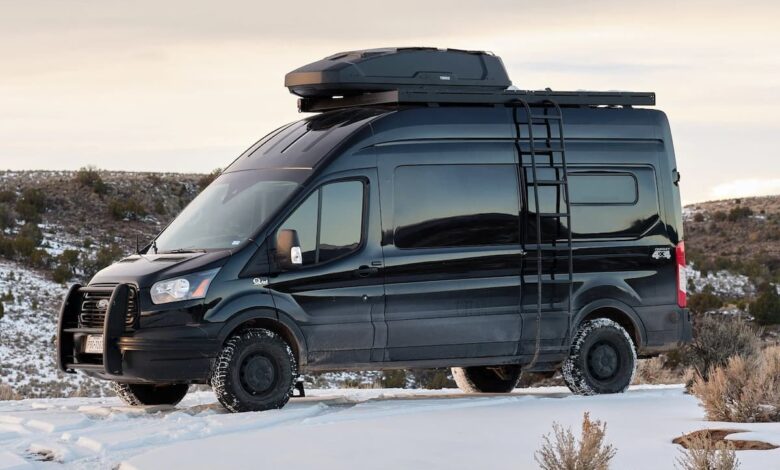The Essentialist’s Rig: A Complete Guide to Minimalist Van Life Tech

The van life movement is a powerful ode to freedom and simplicity. It’s about shedding the excess—the mortgage, the clutter, the conventional lifestyle—in favor of experiences, mobility, and a deeper connection with the world. However, this romantic vision is often powered by a hidden, yet crucial, backbone: technology. The challenge for the modern nomad is to embrace the tech that enables freedom without falling into the trap of recreating the digital clutter they sought to escape.
This is the core philosophy behind minimalist van life tech. It’s not about being anti-technology; it’s about being intentional with technology. It’s a curated approach that prioritizes multi-functional, reliable, and low-footprint gear that enhances your journey rather than complicates it. This guide will walk you through the essential categories of tech, helping you build a smart, streamlined, and truly minimalist rig.
The Philosophy: Less, But Better
Before we dive into specific gadgets, let’s establish the guiding principles of a minimalist tech setup. Every piece of gear you bring into your van should be evaluated against these three criteria:
- Essential Functionality: Does this item solve a core problem related to power, safety, work, or connectivity? If it’s a “nice-to-have” but not a “need-to-have,” it probably doesn’t make the cut.
- Multi-Purpose Design: The holy grail of minimalist tech is the multi-purpose device. Can one gadget do the job of two or three? A phone that is also your GPS, camera, and entertainment center is a prime example.
- Reliability and Durability: In a mobile environment, gear takes a beating. Prioritize robust, well-built items that can handle temperature fluctuations, vibrations, and the occasional bump. A cheap gadget that fails when you’re off-grid is worse than no gadget at all.
Category 1: The Power Core – Your Electrical Foundation
Power is the non-negotiable foundation of any tech setup. Without it, everything else is just dead weight. A minimalist approach focuses on a system that is just powerful enough for your needs, without the overkill and expense of a massive setup.
The Minimalist Power Station (The Heart)
Instead of a complex custom build with separate inverters, charge controllers, and batteries, the minimalist choice is a high-quality portable power station. Brands like Jackery, Goal Zero, and Anker offer all-in-one solutions that combine a lithium-ion battery, a pure sine wave inverter, a solar charge controller, and multiple output ports (AC, DC, USB) in a single, compact unit.
- Why it’s minimalist: It replaces multiple bulky components, simplifies wiring, and is portable, allowing you to take power outside the van.
- Sizing it right: Calculate your daily power needs. For a true minimalist who only needs to charge a laptop, phone, and some lights, a 500Wh to 1000Wh station is often the sweet spot. This provides enough power for a couple of days without taking up excessive space or weight.
Solar: The Silent Fuel
To be truly free, you need a way to recharge. Solar is the quiet, passive, and minimalist way to do it.
- The Minimalist Choice: Flexible or foldable solar panels.
- Flexible Panels: These can be mounted semi-permanently to the roof of your van without the need for a heavy, bulky roof rack. They are aerodynamic and discreet.
- Foldable “Suitcase” Panels: These are the ultimate in minimalist flexibility. They are not permanently mounted, allowing you to park your van in the shade while placing the panels in direct sunlight. They are perfect for nomads who don’t want to make permanent modifications to their vehicle.
- How much solar? For a 500-1000Wh power station, a 100W to 200W solar panel setup is a balanced choice, providing a decent charge on a sunny day without being overly cumbersome.
Category 2: The Connectivity Hub – Staying in Touch
For digital nomads or anyone needing to stay connected with the outside world, reliable internet is key. The minimalist approach avoids complex satellite dishes and focuses on maximizing existing cellular signals.
The Essential Tool: A Cell Signal Booster
A cell signal booster is arguably the most important piece of minimalist van life tech for anyone who works on the road. It doesn’t create a signal, but it captures a weak, unusable signal from a distant tower, amplifies it, and rebroadcasts it inside your van.
- How it works: It consists of three parts: an external antenna (mounted on your roof), the booster unit itself, and an internal antenna inside the van.
- The Minimalist Advantage: A single device can dramatically increase your options for finding beautiful, remote campsites that still have a usable internet connection. It eliminates the need to constantly hunt for coffee shops with Wi-Fi. Brands like weBoost and HiBoost are the industry standards.
The Brain: Your Smartphone or a Mobile Hotspot
- Your Smartphone: For many, a smartphone with a generous data plan is sufficient. When paired with a cell booster, your phone becomes a reliable hotspot for your laptop. This is the ultimate multi-purpose solution.
- Dedicated Mobile Hotspot: If you need a more robust connection or have multiple devices, a dedicated mobile hotspot device can be a worthy addition. It has a more powerful antenna than a phone and doesn’t drain your phone’s battery.
Category 3: Navigation and Safety – Your Digital Co-Pilot
Getting lost can be an adventure, but being safely found is essential.
The Multi-Purpose Navigator: Your Smartphone
Gone are the days of needing a separate GPS unit. Your smartphone is more than capable.
- The App Stack:
- Offline Maps: This is crucial. Use Google Maps’ offline feature or dedicated apps like maps.me or Gaia GPS to download maps for entire regions. This ensures you can navigate even without a cell signal.
- Campsite Finders: Apps like iOverlander, The Dyrt, and Campendium are essential for finding free and paid campsites, water sources, and dump stations.
The Lifeline: A Satellite Messenger
For the minimalist who truly values off-grid exploration, a satellite messenger is a vital piece of safety tech. It’s a small, lightweight device that works where cell phones don’t.
- Core Functionality: It allows you to send pre-set “I’m okay” messages, send and receive short custom texts, and, most importantly, trigger an SOS signal in a life-threatening emergency, which is routed to international rescue coordinators.
- The Minimalist Choice: A device like the Garmin inReach Mini or the Zoleo Satellite Communicator. They are incredibly small, have a long battery life, and can save your life. This single, small device provides immense peace of mind.
Category 4: Comfort and Lifestyle – The Little Luxuries
Minimalism isn’t about deprivation; it’s about intentional comfort.
- Kindle or E-Reader: A Kindle can hold thousands of books in a device smaller and lighter than a single paperback. It is the quintessential minimalist replacement for a physical library.
- Portable Bluetooth Speaker: A small, durable, and waterproof speaker (like a JBL Clip or Anker Soundcore Mini) provides a soundtrack for your life without a complex sound system. It can be used for music, podcasts, or watching movies on a laptop.
- Headlamp: A simple LED headlamp is far more useful than a bulky lantern. It keeps your hands free for cooking, reading, or late-night repairs.
What to Leave Behind: The Anti-Minimalist Tech List
Just as important as what you bring is what you leave behind.
- TVs: A laptop, tablet, or even a small portable projector offers a better, more flexible viewing experience without the bulk and power draw of a TV.
- Microwaves and High-Wattage Appliances: These require a massive and expensive power system. Learn to embrace simpler cooking methods on a propane stove.
- Complex Smart Home Systems: You don’t need voice-activated lights or a smart thermostat in a 70-square-foot space. A simple switch works just fine.
- Redundant Gadgets: Do you really need a separate camera if your phone’s camera is excellent? Do you need a tablet if you have a lightweight laptop? Question every device.
Conclusion: Technology as a Tool, Not a Tether
The ultimate goal of minimalist van life tech is to create a setup that empowers your freedom, not one that ties you down with complexity and maintenance. By focusing on a core of high-quality, multi-functional, and reliable gear, you can build a rig that is both highly capable and beautifully simple.
Your van is a vessel for adventure. The right technology should feel like an invisible co-pilot, quietly working in the background to make your journey safer, more comfortable, and more connected on your own terms. Choose intentionally, pack light, and let the technology serve the journey, not the other way around.



